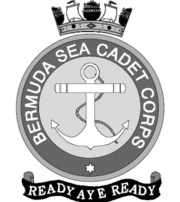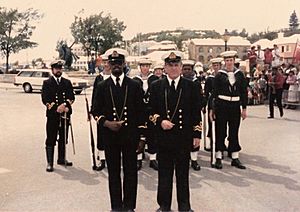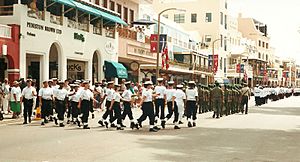Bermuda Sea Cadet Corps facts for kids
Quick facts for kids Bermuda Sea Cadet Corps (BSCC) |
|
|---|---|

The badge of the Bermuda Sea Cadet Corps
|
|
| Founded | 1966 |
| Country | Bermuda (UK) |
| Branch | Royal Navy |
| Type | Volunteer Youth Organisation |
| Size | 3 Training Ships (shore stations) |
| Headquarters Unit | TS Bermuda |
| Motto(s) | Ready Aye Ready |
| Website | TS Bermuda TS Admiral Somers TS Venture |
| Commanders | |
| Lieutenant Commander, Royal Naval Reserve (Sea Cadet Corps) | Lieutenant Commander Michael Frith, RNR (SCC) |
| Notable commanders |
Commander A.J. Boyd, RN ; Lieutenant Commander J. Derek Taylor, RNR (SCC); Lieutenant Commander William Anthony Lightbourne, RNR (SCC); Lieutenant Commander Dwayne Trott, RNR (SCC). |
The Bermuda Sea Cadet Corps is a youth group in Bermuda. It teaches young people about the Royal Navy and maritime skills. It started in 1966 and became an official charity in 1968. However, the very first group of cadets began two years before that.
Contents
What is the Bermuda Sea Cadet Corps?
The Bermuda Sea Cadet Corps is a volunteer youth organization. It is similar to the UK Sea Cadet Corps. The group helps young people in Bermuda learn about naval traditions and life at sea. They also learn important life skills like teamwork and discipline.
How did the Sea Cadets start in Bermuda?

Bermuda has a long history with the sea. It was once an important naval base for the Royal Navy. Even so, there were no Sea Cadet groups until 1964. Other youth groups, like the Army Cadets, had been around for much longer.
The Royal Naval Association in Bermuda decided to create a Sea Cadet unit. This group included people who had served in the Royal Navy. They started organizing the first unit in 1964.
Where are the Sea Cadet units located?
The Bermuda Sea Cadet Corps has three main units. They are called Training Ships (TS), even though they are on land. Each unit is located on land that used to belong to the navy.
- TS Bermuda was the first unit. It opened on January 12, 1966. It is located near Admiralty House in Spanish Point. This area is close to Hamilton, the capital of Bermuda.
- TS Admiral Somers is named after Sir George Somers. He was the founder of Bermuda. This unit is in Convict Bay, St. George's. This area was once a naval base.
- TS Venture is on Ireland Island. This island was the main location for the Royal Naval Dockyard.
The first official inspection of the cadets happened on April 7, 1967. Commander A. J. Boyd from HMS Malabar inspected the TS Bermuda cadets.
How are the Sea Cadets organized and trained?
An Executive Council manages the Bermuda Sea Cadet Corps. This council handles funding, support, and overall administration. Many council members have been retired naval officers.
TS Bermuda is considered the main headquarters unit. Each unit also has its own committee. These committees raise money for their unit's daily needs.
Who are the leaders in the Sea Cadets?
All officers in the Bermuda Sea Cadet Corps are part of the Royal Naval Reserve. Their ranks are followed by "RNR (SCC)". Their uniform badges have a special 'wavy' design.
Each unit is led by a Commander or a Lieutenant-Commander. Below them are junior officers, Warrant Officers, and Cadet Instructors. The cadets themselves have ranks like Cadet Petty Officers and ratings.
What kind of training do cadets receive?
Before the Royal Navy base HMS Malabar closed in 1995, the cadets worked closely with it. The base's commanding officer would inspect the units every year.
Cadets often get to train on Royal Navy ships. They also train on the UK Sea Cadet Corps' tall ship, TS Royalist. The Corps has also supported the building of Bermuda's own tall ship, the Spirit of Bermuda. This ship is used for youth training.
For many years, female cadets were technically part of the Girls Nautical Training Corps. However, they trained alongside the Bermuda Sea Cadet Corps units. This changed in 1992 when the Girls Nautical Training Corps joined the Sea Cadet Corps.
Besides training, the cadets take part in public parades. These include the King's Birthday and Remembrance Day.
What do Sea Cadets wear?
The Bermuda Sea Cadet Corps wears a "cold water" Royal Navy uniform. This includes navy blue trousers and jerseys. They also wear a white shirt and a white cap. The jerseys have "Sea Cadet Corp" shoulder titles.
For everyday work, they wear a blue shirt and darker blue trousers. They also wear a navy blue sweater and a navy blue beret. This beret has a "Sea Cadet Corps" badge. Rank badges are worn on blue slides on the shoulders. These slides also say "SCC".
For special parades, cadets wear white belts and anklets.
Cadet ranks and badges
Cadets earn different ranks as they progress. Each rank has a special badge.
Adult officer ranks and badges
Adult officers in the Sea Cadet Corps also have ranks. Their rank badges are worn on their uniforms.
| Sea Cadet Corps officers | Captain RNR (SCC) | Commander RNR (SCC) | Lieutenant Commander RNR (SCC) | Lieutenant RNR (SCC) | Sub-Lieutenant RNR (SCC) | Midshipman RNR (SCC) |
|---|---|---|---|---|---|---|
| Insignia |  |
 |
 |
 |
 |
 |
| Sea Cadet Unit Officers (NCOs) | Warrant Officer 1 RNR (SCC) | Warrant Officer 2 RNR (SCC) | Chief Petty Officer | Petty Officer | Probationary Petty Officer | Civilian Instructor |
|---|---|---|---|---|---|---|
| Rank Slide |  |
 |
 |
 |
 |
 |
Weapons used for training
The units have Lee-Enfield rifles. These rifles are made safe for drill purpose only. This means they are used for marching and practice, not for shooting. If cadets need to practice shooting, they use rifles borrowed from the Royal Bermuda Regiment.
Officers use ceremonial swords and daggers for special duties.
Gallery












